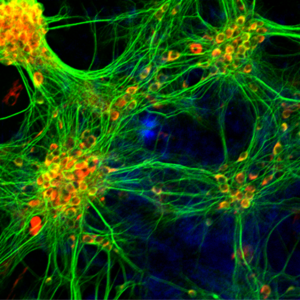Dr. Jana Katharina Dahlmanns
Dr. Jana Katharina Dahlmanns

🔬 About the Lab
The Emergence Lab studies how small neural circuits organize themselves, adapt to challenges, and sometimes fail. We focus on the emergent properties of neuronal networks — collective behaviors such as synchrony, modularity, and attractor dynamics — that cannot be reduced to the behavior of individual neurons.
We use dissociated hippocampal cultures and acute brain slices combined with high-speed calcium imaging and graph-theoretic analysis to investigate how pharmacological agents, neuroactive molecules, and targeted stimulation shape network function over time.
Our work aims to reveal fundamental principles of network-level plasticity, and to understand how external interventions reshape connectivity in ways that support learning, resilience, or dysfunction.
🧪 Research Focus
Network Reorganization and Plasticity
We investigate how circuits reorganize their connectivity in response to pharmacological interventions (e.g., ketamine) or patterned stimulation during network formation and recovery.
Graph-Based Network Analysis
We use custom pipelines to reconstruct functional networks from calcium imaging data, applying graph theory to extract properties like modularity, centrality, and path length.
Activity-Dependent Modulation
We explore how signaling pathways (e.g., Activin A) influence mitochondrial stability and circuit resilience during stress or plasticity-inducing events.

📂 Current Projects
– Network Rewiring After Ketamine Exposure
– Structured Stimulation During Network Reformation in Dissociated Cultures
– Modulatory Effects of Activin A on Plasticity and Metabolic Stability
– Network Graph Features as Markers of Functional Viability in Neural Cultures
👩🔬 Open Positions
Are you curious about how neurons work together to form complex networks — and how these networks adapt, protect, or fail in the face of disease?
We’re offering Bachelor and Master thesis positions in our group, where we explore the emergent properties of biological neuronal networks. Our research spans topics like:
🧠 neuronal network plasticity
🧬 mitochondrial dynamics and metabolic resilience
💊 drug effects on network connectivity
🧨 cell death mechanisms like ferroptosis in glioblastoma
You’ll gain hands-on experience in cutting-edge methods — from live-cell imaging to molecular biology — and be part of a small, collaborative team where curiosity and creativity are always welcome (and cake is occasionally mandatory 🍰).
🔬 Ideal for students in Molecular Medicine, Neuroscience, Medical Engineering or related fields.
🕒 Start date: flexible
📩 Just drop me an email at jana.dahlmanns@fau.de if you’re interested!
Let’s explore the brain — one network at a time.
📚 Selected Publications
🧠 Network Dynamics & Connectivity
-
Wrosch et al., 2017 – Rewiring of neuronal networks during synaptic silencing
→ Quantitative analysis of effective connectivity changes during pharmacologically induced activity suppression in dissociated hippocampal cultures
DOI: 10.1038/s41598-017-11729-5 -
Trepl et al., 2022 – Common network effect-patterns after monoamine reuptake inhibition in dissociated hippocampus cultures
→ Graph-theoretic characterization of antidepressant-induced alterations in network modularity, efficiency, and connectivity degree
DOI: 10.1007/s00702-022-02477-6
🧬 Modulatory Signaling & Plasticity
-
Dahlmanns et al., 2023 – Environmental enrichment recruits activin A to recalibrate neural activity in mouse hippocampus
→ Multi-scale analysis of Activin A signaling effects on excitability, long-term potentiation, and network synchronization in slices and cultures
DOI: 10.1093/cercor/bhac092 -
Dahlmanns et al., 2023 – Glial glutamate transporter-mediated plasticity: system xc-/xCT/SLC7A11 and EAAT1/2 in brain diseases
→ Mechanistic review of glutamate transporter systems in neuroplasticity, excitotoxicity, and adaptive compensation in CNS disorders
DOI: 10.31083/j.fbl2803057
🧨 Cell Death & Tumor Biology
-
Dahlmanns et al., 2021 – Genetic profiles of ferroptosis in malignant brain tumors and off-target effects of ferroptosis induction
→ Comparative analysis of ferroptosis-relevant gene networks in gliomas with discussion of neurotoxicity risks in therapeutic targeting
DOI: 10.3389/fonc.2021.783067
